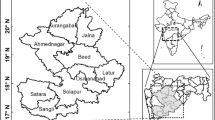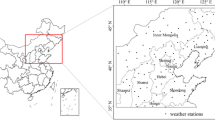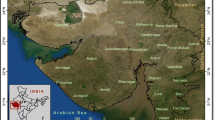Abstract
Drought is one of the most devastating natural hazards in the world, affecting millions of individuals in in different ways, so it's better monitoring and comprehensive assessment is important. Univariate or multivariate drought indices are able to monitor one type of drought and can not reflect comprehensive drought information from meteorological to agricultural aspects. For this purpose, by combining the Vegetation Condition Index (VCI), Temperature Condition Index (TCI), the Soil Water Index (SWI) and the precipitation condition index (PCI) a comprehensive drought index called Combined Drought Index (CDI) was proposed. In this study, meteorological and agricultural droughts from 2001 to 1397 in Karkheh Basin in southwestern Iran were monitored. The Principal Component Analysis (PCA) method, which is a mainstay of modern data analysis tools for constructing a composite index, was applied to a data matrix that contains the time series of the computed PCI, VCI, TCI, and SWI indices for a given location, and the first leading component of the PCA was introduced as CDI index. The results indicated that the highest correlation (r = 0.53, r = 0.56) between the CDI, SPI-1 and SDI was observed respectively, which indicates the ability of this index for drought comprehensive monitoring. It is also suggested that in order to improve the performance of the CDI, in addition to the considered parameters in this study, other factors affecting the performance of each of the remote sensing indicators such as vegetation type, plant root, soil texture type, evaporation and Transpiration also be considered in future studies.













Similar content being viewed by others
Data and material availability
The datasets used and/or analyzed during the current study are available from the corresponding author on request.
Code availability
Software applications or custom code used during the current study are available from the corresponding author on reasonable request.
References
Amalo LF (2017) Hidayat R (2017) Comparison between remote-sensing-based drought indices in east Java. IOP Conf. Series 54:012009. https://doi.org/10.1088/1755-315/54/1/012009
Anyamba A, Tucker CJ, Eastman JR (2001) NDVI anomaly patterns over Africa during the 1997/98 ENSO warm event. Int J Remote Sens 22:1847–1859. https://doi.org/10.1080/01431160010029156
Baniya B, Tang Q, Xu X, Haile GG, Chhipi-Shrestha G (2019) Spatial and temporal variation of drought based on satellite derived vegetation condition index in Nepal from 1982–2015. Sensors 19(2):430. https://doi.org/10.3390/s19020430
Bayarjargal Y, Karnieli A, Bayasgalan M, Khudulmur S, Gandush C, Tucker CJ (2006) A comparative study of NOAA–AVHRR derived drought indices using change vector analysis. Remote Sens Environ 105(1):9–22. https://doi.org/10.1016/j.rse.2006.06.003
Bazrafshan J, Hejabi S, Rahimi J (2014) Drought monitoring using the Multivariate Standardized Precipitation index (MSPI). Water Resour Manage. https://doi.org/10.1007/s11269-014-0533-2
Begueria S, Vicente-Serrano SM, Reig F, Latorre B (2014) Standardized precipitation evapotranspiration index (SPEI) revisited: parameter fitting, evapotranspiration models, tools, datasets and drought monitoring. Int J Climatol 34(10):3001–3023. https://doi.org/10.1002/joc.3887
Chang J, Li Y, Wang Y, Yuan M (2016) Copula-based drought risk assessment combined with an integrated index in the Wei River Basin. China J Hydrol 540:824–834. https://doi.org/10.1016/j.jhydrol.2016.06.064
Chen S, Zhong W, Pan S, Xie Q, Kim TW (2020) Comprehensive drought assessment using a modified composite drought index: a case study in Hubei Province. China Water 12(2):462. https://doi.org/10.3390/w12020462
Cong D, Zhao S, Chen C, Duan Z (2017) Characterization of droughts during 2001–2014 based on remote sensing: a case study of Northeast China. Eco Inform 39:56–67. https://doi.org/10.1016/j.ecoinf.2017.03.005
Deng JS, Wang K, Deng YH, Qi GJ (2008) PCA-based land-use change detection and analysis using multitemporal and multisensor satellite data. Int J Remote Sens 29(16):4823–4838. https://doi.org/10.1080/01431160801950162
Dracup JA, Lee KS, Paulson EGJr, (1980) on the statistical characteristics of drought events. Water Resour Res 16(2):289–296. https://doi.org/10.1029/WR016i002p00289
Du L, Tian Q, Yu T, Meng Q, Jancso T, Udvardy P, Huang Y (2013) A comprehensive drought monitoring method integrating MODIS and TRMM data. Int J Appl Earth Obs Geoinf 23:245–253. https://doi.org/10.1016/j.jag.2012.09.010
Dutta D, Kundu A, Patel NR, Saha SK, Siddiqui AR (2015) Assessment of agricultural drought in Rajasthan (India) using remote sensing derived Vegetation Condition Index (VCI) and Standardized Precipitation Index (SPI). Egypt J Remote Sens Space Sci 18(1):53–63. https://doi.org/10.1016/j.ejrs.2015.03.006
Fassouli VP, Karavitis CA, Tsesmelis DE, Alexandris SG (2021) Factual Drought Index (FDI): a composite index based on precipitation and evapotranspiration. Hydrol Sci J 66(11):1638–1652. https://doi.org/10.1080/02626667.2021.1957477
Fatehi maraj A, Heydarian SA, (2013) Investigation of meteorological, agricultural and hydrological drought using GIS in Khuzestan province. Iran-Watershed Manage Sci Eng 7(23):19–32 (In Persian)
Guo E, Wang Y, Jirigala B, Jin E (2020) Spatiotemporal variations of precipitation concentration and their potential links to drought in mainland China. J Clean Prod 267:1–14. https://doi.org/10.1016/j.jclepro.2020.122004
Han Y, Li Z, Huang C, Zhou Y, Zong S, Hao T, Niu H, Yao H (2020) Monitoring droughts in the Greater Changbai Mountains using multiple remote sensing-based drought indices. Remote Sens 12(3):530. https://doi.org/10.3390/rs12030530
Hao C, Zhang J, Yao F (2015) Combination of multi-sensor remote sensing data for drought monitoring over Southwest China. Int J Appl Earth Obs Geoinf 35:270–283. https://doi.org/10.1016/j.jag.2014.09.011
Hu X, Ren H, Tansey K, Zheng Y, Ghent D, Liu X, Yan L (2019) Agricultural drought monitoring using European Space Agency Sentinel 3A land surface temperature and normalized difference vegetation index imageries. Agric Meteorol 279:107707. https://doi.org/10.1016/j.agrformet.2019.107707
Huang S, Chang J, Huang Q, Chen Y (2014) Spatio-temporal changes and frequency analysis of drought in the Wei River Basin China. Water Resources Manage 28(10):3095–3110. https://doi.org/10.1007/s11269-014-0657-4
Ji L, Peters A (2003) Assessing vegetation response to drought in the northern Great Plains using vegetation and drought indices. Remote Sens Environ 87:85–89. https://doi.org/10.1016/S0034-4257(03)00174-3
Jiao W, Tian C, Chang Q, Novick KA, Wang L (2019) A new multi-sensor integrated index for drought monitoring. Agric Meteorol 268:74–85. https://doi.org/10.1016/j.agrformet.2019.01.008
Jiao W, Wang L, McCabe MF (2021) Multi-sensor remote sensing for drought characterization: current status, opportunities and a roadmap for the future. Remote Sens Environ 256:112313. https://doi.org/10.1016/j.rse.2021.112313
Jiao W, Zhang L, Chang Q, Fu D, Cen Y, Tong Q (2016) Evaluating an enhanced vegetation condition index (VCI) based on VIUPD for drought monitoring in the continental United States. Remote Sensing 8(3):224. https://doi.org/10.3390/rs8030224
Karimi M, Shahedi K, Raziei T, Miryaghoubzadeh M (2019) Analysis of Performance of vegetation indices on agricultural drought using remote sensing technique in Karkheh basin. J Remote Sens GIS 11(4):29–46 (In Persian)
Karimi M, Vicente-Serrano SM, Reig F, Shahedi K, Raziei T, Miryaghoubzadeh M (2020) Recent trends in atmospheric evaporative demand in Southwest Iran: implications for change in drought severity. Theoret Appl Climatol 142(3):945–958. https://doi.org/10.1007/s00704-020-03349-3
Karnieli A, Agam N, Pinker RT, Anderson M, Imhoff ML, Gutman GG, Panov N, Goldberg A (2010) Use of NDVI and land surface temperature for drought assessment: merits and limitations. J Clim 23(3):618–633. https://doi.org/10.1175/2009JCLI2900.1
Keyantash JA, Dracup JA (2004) An aggregate drought index: assessing drought severity based on fluctuations in the hydrologic cycle and surface water storage. Water Resour Res 40(9):1–13. https://doi.org/10.1029/2003WR002610
Kavianpour M, Seyedabadi M, Moazami S (2018) Spatial and temporal analysis of drought based on a combined index using copula. Environ Earth Sci 77(22):1–12. https://doi.org/10.1007/s12665-018-7942-0
Khodaei M, Shad R, Maghsudi mehari Y, Ghemi M, (2016) Determining an optimal multi-sensor remote sensing index to improve the real-time drought monitoring process in areas with heterogeneous land cover. Ecohydrology 3(3):439–454 (In Persian)
Kogan F (1995a) Application of vegetation index and brightness temperature for drought detection. Adv Space Res 15(11):91–100. https://doi.org/10.1016/0273-1177(95)00079-T
Kogan F (1995b) Droughts of the late 1980s in the United States as derived from NOAA polar-orbiting satellite data. Bull Am Meteor Soc 76(5):655–668. https://doi.org/10.1175/1520-0477(1995)076%3c0655:DOTLIT%3e2.0.CO;2
Kogan F (1997) Global drought watches from space. Bull Am Meteor Soc 78(4):621–636. https://doi.org/10.1175/1520-0477(1997)078%3c0621:GDWFS%3e2.0.CO;2
Kulkarni SS, Wardlow BD, Bayissa YA, Tadesse T, Svoboda MD, Gedam SS (2020) Developing a remote sensing-based combined drought indicator approach for agricultural drought monitoring over Marathwada India. Remote Sens 12(13):2091. https://doi.org/10.3390/rs12132091
Kwon HJ, Kim SJ (2010) Assessment of distributed hydrological drought based on hydrological unit map using SWSI drought index in South Korea. KSCE J Civ Eng 14(6):923–929. https://doi.org/10.1007/s12205-010-0827-8
Li X, He B, Quan X, Liao Z, Bai X (2015) Use of the standardized precipitation evapotranspiration index (SPEI) to characterize the drying trend in southwest China from 1982–2012. Remote Sens 7(8):10917–10937. https://doi.org/10.3390/rs70810917
Li Z, Han Y, Hao T (2020) Assessing the consistency of remotely sensed multiple drought indices for monitoring drought phenomena in continental China. IEEE Trans Geosci Remote Sens 58(8):5490–5502. https://doi.org/10.1109/TGRS.2020.2966658
Liu Q, Zhang S, Zhang H, Bai Y, Zhang J (2020) Monitoring drought using composite drought indices based on remote sensing. Sci Total Environ 711:134585. https://doi.org/10.1016/j.scitotenv.2019.134585
Liu Y, Zhu RL, Yong B, Singh VP, Yuan F, Jiang S, Yang X (2019) On the mechanisms of two composite methods for construction of multivariate drought indices. Sci Total Environ 647:981–991. https://doi.org/10.1016/j.scitotenv.2018.07.273
Ma M, Ren L, Yuan F, Jiang S, Liu Y, Kong H, Gong L (2014) A new standardized Palmer drought index for hydro-meteorological use. Hydrol Process 28(23):5645–5661. https://doi.org/10.1002/hyp.10063
Mainali J, Pricope NG (2017) High-resolution spatial assessment of population vulnerability to climate change in Nepal. Appl Geogr 82:66–82. https://doi.org/10.1016/j.apgeog.2017.03.008
Mallick K, Bhattacharya BK, Patel NK (2009) Estimating volumetric surface moisture content for cropped soils using a Soil Wetness Index based on surface temperature and NDVI. Agric for Meteorol 149:1327–1342. https://doi.org/10.1016/j.agrformet.2009.03.004
McKee TB, Doesken NJ, Kleist J (1993) The relationship of drought frequency and duration to time scales. In Eighth Conference on Applied Climatology, 17–22 January, Anaheim, CA, 179–184. DOI: https://doi.org/10.4236/oalib.1104254.
Mirahsani MS, Mahini AR, Safanian AR, Modares R, Jafari R, Mohamadi J (2017) Regional drought monitoring of Zayandeh-Rud basin based on index time series changes VCI index MODIS Sensors and SPI index. J Geogr Environ Hazards 24(1):1–22. https://doi.org/10.22067/geo.v6i4.62601(In Persian)
Mirmousavi SH, Kareimei H (2013) Effect of drought on vegetation cover using MODIS sensing images case: Kurdistan province. Geography and Development 11(31):57–76. https://doi.org/10.22111/gdij.2013.794(In Persian)
Mishra D, Goswami S, Matin S, Sarup J (2021) Analyzing the extent of drought in the Rajasthan state of India using vegetation condition index and standardized precipitation index. Model Earth Syst Environ https://doi.org/10.1007/s40808-021-01102-x
Moazzenzadeh R, Arshad S, Ghahraman B, Davari K (2013) Drought monitoring in unirrigated lands based on the remote sensing technique. Water Irrig Manag 2(2):39–52. https://doi.org/10.22059/jwim.2013.30339 (In Persian)
Muukkonen P, Nevalainen S, Lindgren M, Peltoniemi M (2015) Spatial occurrence of drought-associated damages in Finnish boreal forests: results from forest condition monitoring and GIS analysis. J Boreal Environ Res 20:172–180
Nalbantis I, Tsakiris G (2009) Assessment of hydrological drought revisited. Water Resour Manage 23(5):881–897. https://doi.org/10.1007/s11269-008-9305-1
Nourani V, Molajou A, Uzelaltinbula S, Sadikoglu F (2019a) Emotional artificial neural networks (EANNs) for multi-step ahead prediction of monthly precipitation; case study: northern Cyprus. Theoret Appl Climatol 138(3):1419–1434. https://doi.org/10.1007/s00704-019-02904-x
Nourani V, Razzaghzadeh Z, Baghanam AH, Molajou A (2019b) ANN-based statistical downscaling of climatic parameters using decision tree predictor screening method. Theoret Appl Climatol 137(3):1729–1746. https://doi.org/10.1007/s00704-018-2686-z
Orville HD (1990) AMS statement on meteorological drought. Bull Am Meteorol Soc 71(7):1021–1025
Palmer, W.C., 1965. Meteorological drought. US Department of Commerce, Weather Bureau. 30: 58 p.
Parviz L, Khailghi M, (2011) Evaluation of the efficiency of indicators resulting from remote sensing technology in assessing meteorological drought (Case study: Sefidrood catchment). Geogr Dev Iran J 9(22):147–164 (In Persian)
Porhemat J, Razi T, Rahimibandarabadi S (2015) Investigation on Spatio-temporal Variability of Meteorological Drought in Southwestern Iran (case study in Karkheh basin). Irrigat Water Eng 5(3):60–79
Qaiser G, Tariq S, Adnan S, Latif M (2021) Evaluation of a composite drought index to identify seasonal drought and its associated atmospheric dynamics in Northern Punjab, Pakistan. J Arid Environ 185: https://doi.org/10.1016/j.jaridenv.2020.104332
Quiring SM, Ganesh S (2010) Evaluating the utility of the vegetation condition index (VCI) for monitoring meteorological drought in Texas. Agric for Meteorol 150(3):330–339. https://doi.org/10.1016/j.agrformet.2009.11.015
Quiring SM, Papakryiakou TN (2003) An evaluation of agricultural drought indices for the Canadian prairies. Agric Meteorol 118(1–2):49–62. https://doi.org/10.1016/S0168-1923(03)00072-8
Rajsekhar D, Singh VP, Mishra AK (2015) Multivariate drought index: AN information theory based approach for integrated drought assessment. J Hydrol 526:164–182. https://doi.org/10.1016/j.jhydrol.2014.11.031
Raziei T, Saghafian B, Paulo AA, Pereira LS, Bordi I (2009) Spatial and temporal variability of drought in western Iran. Water Resour Manag 23:439–455. https://doi.org/10.1007/s11269-008-9282-4
Rezaei Banafsheh M, Rezaei A, Faridpor M (2015) Analyzing agricultural drought in east Azarbaijan province emphasizing remote sensing technique and vegetation condition index. Water Soil Sci (agric Sci) 25(1):113–123 (In Persian)
Rezaei Moghadam MH, Valizadeh Kamran KH, Rostamzadeh H, Rezaei A (2012) Evaluating the adequacy of MODIS in the assessment of drought (case study: Urmia lake basin). Geogr Environ Sustain 2(5):37–52 (In Persian)
Rhee J, Im J, Carbone GJ (2010) Monitoring agricultural drought for arid and humid regions using multi-sensor remote sensing data. Remote Sens Environ 114(12):2875–2887. https://doi.org/10.1016/j.rse.2010.07.005
Richard R, Jr H (2002) A review of twentieth-century drought indices used in the United States. Bull Am Meteor Soc 83(8):1149–1166. https://doi.org/10.1175/1520-0477-83.8.1149
Roswintiarti O, Sofan P, Anggraini N (2011) Monitoring of drought-vulnerable area in Java Island, Indonesia using satellite remote-sensing data. Jurnal Penginderaan Jauh Dan Pengolahan Data Citra Digital 8:21–34
Seiler RA, Kogan F, Wei G (2000) Monitoring weather impact and crop yield from NOAA AVHRR data in Argentina. Adv Space Res 26(7):1177–1185. https://doi.org/10.1016/S0273-1177(99)01144-8
Shafer BA, Dezman LE (1982) January. Development of surface water supply index (SWSI) to assess the severity of drought condition in snowpack runoff areas. Proceeding of the Western Snow Conference. Colo. State Univ. Fort Collins, pp 164–175
Soh YW, Koo CH, Huang YF, Fung KF (2018) Application of artificial intelligence models for the prediction of standardized precipitation evapotranspiration index (SPEI) at Langat River Basin, Malaysia. Comput Electron Agric 144:164–173. https://doi.org/10.1016/j.compag.2017.12.002
Sur C, Park SY, Kim TW, Lee JH (2019) Remote sensing-based agricultural drought monitoring using hydrometeorological variables. KSCE J Civ Eng 23(12):5244–5256. https://doi.org/10.1007/s12205-019-2242-0
Van Hoek M, Jia L, Zhou J, Zheng C, Menenti, (2016) Early drought detection by spectral analysis of satellite time series of precipitation and normalized difference vegetation index (NDVI). Remote Sens 8(5):422. https://doi.org/10.3390/rs8050422
Vicente-Serrano SM, Beguería S, López-Moreno JI (2010) A multiscalar drought index sensitive to global warming: the standardized precipitation evapotranspiration index. J Clim 23(7):1696–1718. https://doi.org/10.1175/2009JCLI2909.1
Vicente-Serrano SM, Beguería S, López-Moreno JI (2011) Comment on “Characteristics and trends in various forms of the Palmer Drought Severity Index (PDSI) during 1900–2008” by Aiguo Dai. J Geophys Res 116(D19):1–9. https://doi.org/10.1029/2011JD016410
Wambua RM (2019) Hydrological drought forecasting using modified surface Water Supply Index (SWSI) and Streamflow Drought Index (SDI) in conjunction with artificial neural networks (ANNs). Int J Serv Sci Manage Eng Technol (IJSSMET) 10(4):39–57. https://doi.org/10.4018/IJSSMET.2019100103
Wang K, Li T, Wei J (2019) Exploring drought conditions in the three river headwaters region from 2002 to 2011 using multiple drought indices. Water 11(2):190. https://doi.org/10.3390/w11020190
Wang W, Zhang ZZ, Wang XG, Wang HM (2012) Evaluation of using the modified water deficit index derived from MODIS vegetation index and land surface temperature products for monitoring drought. In: 2012 IEEE international geoscience and remote sensing symposium, 5951–5954. Doi: https://doi.org/10.1109/IGARSS.2012.6352253.
Waseem M, Ajmal M, Kim TW (2015) Development of a new composite drought index for multivariate drought assessment. J Hydrol 527:30–37. https://doi.org/10.1016/j.jhydrol.2015.04.044
Wei W, Zhang J, Zhou L, Xie B, Zhou J, Li C (2021) Comparative evaluation of drought indices for monitoring drought based on remote sensing data. Environ Sci Pollut Res 28(16):20408–20425. https://doi.org/10.1007/s11356-020-12120-0
Wells N, Goddard S, Hayes MJ (2004) A self-calibrating Palmer drought severity index. J Clim 17(12):2335–2351. https://doi.org/10.1175/1520-0442(2004)017%3c2335:ASPDSI%3e2.0.CO;2
Winkler K, Gessner U, Hochschild V (2017) Identifying droughts affecting agriculture in Africa based on remote sensing time series between 2000–2016: rainfall anomalies and vegetation condition in the context of ENSO. Remote Sens 9(831):1–27. https://doi.org/10.3390/rs9080831
Xu K, Yang D, Xu X, Lei H (2015) Copula based drought frequency analysis considering the spatio-temporal variability in Southwest China. J Hydrol 527:630–640. https://doi.org/10.1016/j.jhydrol.2015.05.030
Yang J, Chang J, Wang Y, Li Y, Hu H, Chen Y, Huang Q, Yao J (2018) Comprehensive drought characteristics analysis based on a nonlinear multivariate drought index. J Hydrol 557:651–667. https://doi.org/10.1016/j.jhydrol.2017.12.055
Yang L, Wylie BK, Tieszen LL, Reed BC (1998) An analysis of relationships among climate forcing and time-integrated NDVI of grasslands over the US northern and central Great Plains. Remote Sens Environ 65(1):25–37. https://doi.org/10.1016/S0034-4257(98)00012-1
Zambrano F, Lillo-Saavedra M, Verbist K, Lagos O (2016) Sixteen years of agricultural drought assessment of the BioBío region in Chile using a 250 m resolution Vegetation Condition Index (VCI). Remote Sensing 8(6):530. https://doi.org/10.3390/rs8060530
Zargar A, Sadiq R, Naser B, Khan FI (2011) A review of drought indices. Environ Rev 19:333–349. https://doi.org/10.1139/a11-013
Zeng L, Shan J, Xiang D (2014) March. Monitoring drought using multi-sensor remote sensing data in cropland of Gansu Province. In: IOP conference series: earth and environmental science (Vol. 17, No. 1, p. 012017). IOP Publishing
Zhang A, Jia G (2013) Monitoring meteorological drought in semiarid regions using multi-sensor microwave remote sensing data. Remote Sens Environ 134:12–23. https://doi.org/10.1016/j.rse.2013.02.023
Zhang L, Jiao W, Zhang H, Huang C, Tong Q (2017) Studying drought phenomena in the Continental United States in 2011 and 2012 using various drought indices. Remote Sens Environ 190:96–106
Funding
There is no funding regarding this paper.
Author information
Authors and Affiliations
Contributions
MK: Conceptualization, statistical analysis, model implementation, writing original draft and review and editing. KS:: Conceptualization, review, and editing. TR: Conceptualization, review, and editing.MM: review and editing.
Corresponding author
Ethics declarations
Conflict of interest
The authors declare that they have no competing interests.
Ethical approval
Not applicable.
Consent to participate
All authors acknowledge their participation.
Consent for publication
All the authors read the paper, approved the final manuscript, and agreed to its submission to the Journal of Stochastic Environmental Research and Risk Assessment.
Additional information
Publisher's Note
Springer Nature remains neutral with regard to jurisdictional claims in published maps and institutional affiliations.
Rights and permissions
About this article
Cite this article
Karimi, M., Shahedi, K., Raziei, T. et al. Meteorological and agricultural drought monitoring in Southwest of Iran using a remote sensing-based combined drought index. Stoch Environ Res Risk Assess 36, 3707–3724 (2022). https://doi.org/10.1007/s00477-022-02220-3
Accepted:
Published:
Issue Date:
DOI: https://doi.org/10.1007/s00477-022-02220-3




